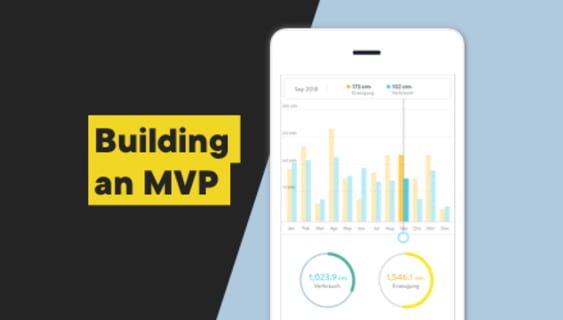The best ways to validate MVPs
The purpose of creating a minimum viable product (MVP) is to test the key features of your digital product with users. It’s a critical process of validation for both the product and the underlying business idea. The results influence the further development of the final product in line with the build-measure-learn approach that we take at Boldare, ultimately leading to product-market fit. This article focuses on that process of validation, including the various best practices, techniques, and types of MVP used. For more on what an MVP is and why it is so important in the development of digital products, check out our article, “MVP development – what, why and how?”.

Table of contents
The importance of the MVP validation process
Ultimately, a digital product’s success depends on how well it addresses users’ needs and pain points. What do they think? Will they use it? Would they recommend it? The whole point of an MVP is to validate the product idea and initial design direction. It’s a continuous process and the benefits include minimizing development costs, faster time to market, establishing an initial user base for the product, and even attracting investors.
MVP validation technique #1: User interviews
Interviewing users is a validation method that allows you to be sure that you are gathering useful feedback. After all, you’re talking to people who represent the product’s target market. Interviews are also a means to dig deep – you may start with standard questions, but you can follow them up, exploring issues further depending on the answers you get.
Aside from the issues mentioned above (initial impressions, utility, does it solve the right issues, etc.) you can also identify any bottlenecks in the user journey when using the MVP – which stages are causing a problem – and rank them in terms of their impact on the user.
A further benefit of user interviews is that by exposing the MVP version to the target market, you are effectively promoting your product-in-development without actively promoting it.
MVP validation technique #2: Explainer videos
Another common validation method is to produce a video showcasing your MVP. The key advantage here is that you can potentially reach a much larger group of people than with user interviews; although the feedback won’t be as in-depth.
With a short video, you have complete control and can demonstrate your MVP at its best, walking viewers through the user journey, and showing off the features under ideal circumstances. Furthermore, you can finish with a call to action, inviting people to sign up to receive updates on the product’s development progress – thus continuing to build the potential user base.
MVP validation technique #3: A/B testing
A/B testing is a tried and trusted method of evaluating the effectiveness of ads, marketing, design, written copy, and… minimum viable products. Also known as split testing, it is used to gather data regarding the product or feature’s appeal to its target audience.
Representative users are shown two versions of the MVP or feature to establish which is more attractive and/or effective.
A/B testing is focused on gathering hard data relating to a specific metric (e.g. bounce rate, conversion rate, frequency of use, etc.); such data can then be statistically analyzed, using tools such as Google Analytics.
MVP validation technique #4: Hallway testing
Hallway testing is a straightforward technique for gathering feedback from potential users. The name is based on the idea of setting up in a hallway and asking people passing by to give their opinion of the product.
With hallway testing, questions focus on the MVP’s user interface and how easy it is to use the product. This method of MVP validation has the advantages of being fast, informal, cheap, and relatively easy to set up and conduct. It’s another way of putting your MVP out into the real world. That said, its casual nature means that hallway testing should not be the sole technique used to validate your MVP – it works well in combination with other methods.
MVP validation technique #5: Social media microsurveys
You could say that social media microsurveys are similar to hallway testing but are carried out online. As with hallway testing, microsurveys are quick and cheap to carry out. They are also quite limited, typically putting just a few questions to users. However, the big advantage is the potential reach of social media – microsurveys can be especially useful if you already have a significant online following or community.
Again, social media microsurveys should not be the only method you use to validate your MVP, but they can add an extra layer of feedback to the validation process. Microsurveys are potentially very effective when combined with an explainer video, asking users to complete a handful of ‘reaction’ questions after viewing.
Types of MVP
Another way of focusing your MVP validation efforts is to seek feedback on a specific, limited, or even manual type of minimum viable product. For example:
- Concierge MVP – This involves offering a personalized service to selected users to test their response. The service is usually human rather than digital (allowing a high degree of direct and responsive service) because what you’re testing isn’t the digital design but the service/business idea itself. A concierge MVP is a low-resource option used early in the product development process.
- Manual-first MVP – Very similar to the concierge MVP, the manual-first option (also known as a “Wizard of Oz” MVP) appears to be fully functional, but orders are fulfilled manually by a ‘human backend’ behind the scenes.
- Single-feature MVP – One way to speed up MVP validation and either spread or reduce the cost of testing is to create a single-feature MVP. As it sounds, this option presents to users just one key feature of your digital product, gathering very focused feedback in the process.
For a selection of MVPs developed by Boldare in cooperation with our partners, check out our case studies.
How to validate MVPs?
Producing a minimum viable product is an almost essential stage in the digital product development process. But it is not enough simply to create an MVP and ask people, what do you think? Specific MVP validation techniques are used to produce more focused feedback, testing whether your product and business idea really does address the target user audience’s needs and wants. What’s more, the right combination of MVP validation techniques – depending on the product and your business goals – can help you gauge market interest in your product-to-be and establish the beginnings of a user base; all while minimizing your initial investment in the development process.
Share this article:








